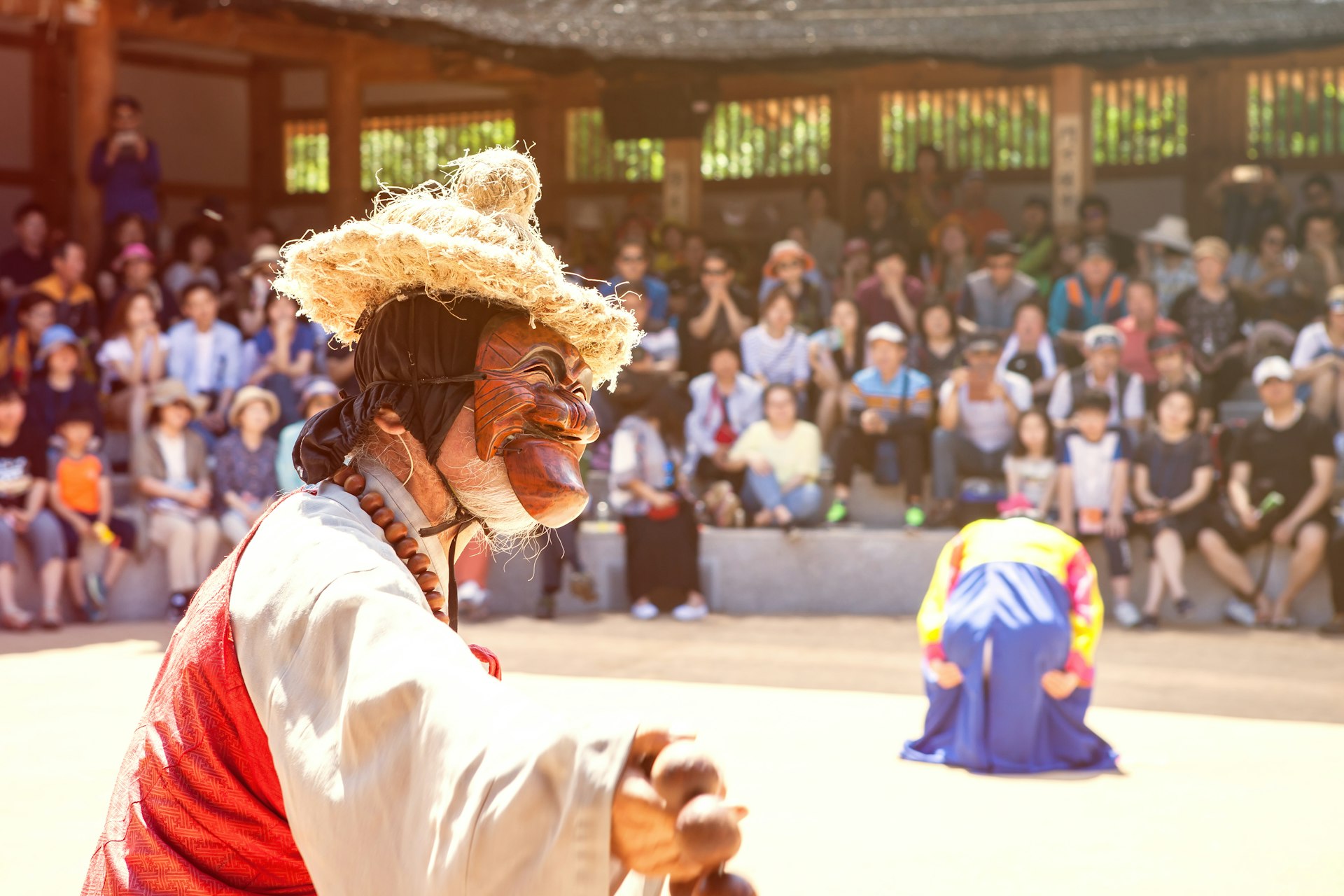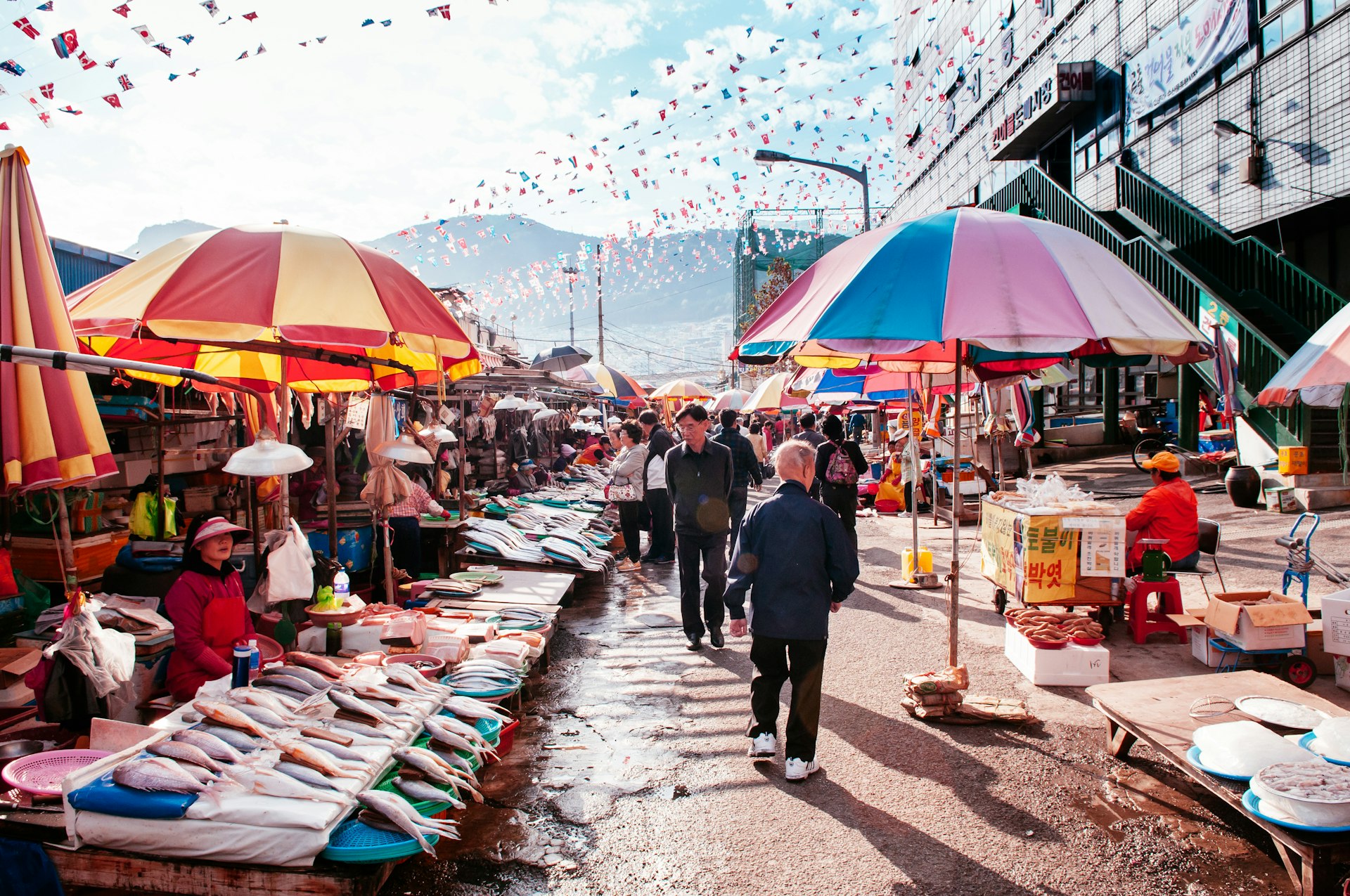Though it may be fun-size compared to its neighbors China and Russia, South Korea more than holds its own when it comes to incredible landscapes, cultural attractions and a dazzling food and nightlife scene.
In fact, South Korea’s size paired with its ultra-reliable public transit system is what makes it all so accessible. Travelers can go from mountaintop to beachside or from village to megacity – and back again – in a single day. Not that we recommend rushing your journey – with so many unique places to visit, you could dedicate an entire trip to one spot. Start your travel to-do list now with our seven favorite places to visit in South Korea.
1. Seoul
Best place for nightlife
Home to half of South Korea’s population, Seoul is also the most popular city for tourists to visit. The capital has an electric vibe at any hour of the day or night. Between the city’s low-key watering holes, high-end cocktail lounges and always-fun noraebang (karaoke bars), Seoul has something to offer every late-night reveler.
Some of the newest trendsetting bars are located in Euljiro, while many longstanding favorites are in the tried-and-true nightlife neighborhoods of Gangnam, Hongdae and Itaewon. Gangnam is where the most expensive clubs are concentrated, while Hongdae is a more affordable option for budget-conscious travelers and university students. Itaewon has a reputation for drawing an international crowd.
2. Busan
Best place for maritime culture
Situated on the southern coast, South Korea’s second city, Busan, overflows with a maritime culture as lively as it is varied. Setting the tone is Busan Port, the oldest and largest in the country (and also the sixth-busiest in the world), handling some 80% of South Korea’s container cargo. The nearby Busan Modern History Museum tells the story of the port’s pivotal role in South Korea’s history. From there, up and down the coastline are any number of beautiful beaches, parks, observatories, villages and even a temple, Haedong Yonggungsa, one of the country’s only oceanside temples.
At Jagalchi, South Korea’s largest fish market, the day’s catch is arranged in stall after stall of fish, eel, crabs, sea squirts, abalone, and more. Shoppers can select their seafood on the ground level and then take it up to one of the restaurants on the floors above, where the staff will expertly de-scale, de-shell, gut or filet and then cook it for you. For other scrumptious seafood bites, look for restaurants along the beach specializing in jogae gui, grilled shellfish served with a variety of dipping sauces like chogochujang (vinegar red pepper sauce), soy sauce with wasabi, and melted butter with onions.
3. Gyeongju
Best place to discover ancient treasures
As the capital of the Silla Kingdom, when the city was called Donggyeong (“eastern capital”), Gyeongju is a treasure trove of ancient relics, religious to royal. Gyeongju National Museum houses a fair number of them – including ornate jewelry, earthenware jars, prayer bells and Buddha statues – but even more artifacts lie beyond. Gyeongju is known as South Korea’s museum without walls.
See the royal tombs of Tumuli-gongwon; the oldest astrological observatory in East Asia, Cheomseongdae; the Buddhist grotto of Seokguram; the picturesque palace of Donggung; and the temple halls, pagodas and bridges of Bulguk-sa. Woljeonggyo, a covered wooden bridge with striking red columns, green roof beams and two end towers, might be the prettiest bridge in all of South Korea – even more so at night when it’s illuminated with lights.
4. Gwangju
Best place for contemporary history
Regarded as the birthplace of Korean democracy, Gwangju was the site of the May 18 Democratic Uprising of 1980, the 10-day-long armed resistance against Chun Doo-hwan’s authoritarian military regime. After the brutal repression of some 600 university student protesters, the people of Gwangju stood up and joined in rebellion, resulting in state massacre and torture. Despite the movement’s suppression, it’s seen as a turning point in South Korea’s struggle for democracy.
To better understand this pivotal event in the country’s history, go to the May 18th Memorial Park and National Cemetery. You can also take a walk down Chungjang-ro, a now-converted shopping and entertainment street that was once ground zero of the uprising.
5. Jeju-do
Best place for beaches and waterfalls
South of the Korean mainland in the Yellow Sea, Jeju-do is blessed with a balmy subtropical climate, making it the country’s most popular vacation destination. The island is in such high demand that the flight between Seoul and Jeju City is the busiest air route in the world. Just one glimpse of Jeju’s glittering white-sand and black-sand beaches, crystal-clear waters and volcanic topography of calderas, cones and tuffs, and it’s easy to see why so many mainlanders flock to the island for a bit of R&R.
While Jeju’s beaches make the perfect natural setting for lounging oceanside with a book and a cocktail, the island has plenty more to do than just relax. Aside from climbing the country’s tallest mountain, Hallasan, outdoors adventure seekers can go surfing at Woljeongri or Jungmun beaches, snorkeling and scuba diving at Munseom Island, spelunking in the Geomunoreum Lava Tube System, waterfall chasing at Jeongbang Pokpo or Cheonjiyeon Pokpo, or tewoo rafting aboard a traditional Jeju boat at the Soesokkak Estuary.
6. Gangwon-do
Best place for winter sports
The site of the 2018 Pyeongchang Winter Olympics, Gangwon-do is home to the best ski resorts in South Korea. For skiing and snowboarding, head to top-rated Yongpyong, the country’s oldest and largest ski resort, or High1, featuring a casino and revolving restaurant. Other popular options are Phoenix Park, Vivaldi Park and Alpensia.
The frosty fun doesn’t stop there – Gangwon also hosts several winter festivals, including the Hwacheon Sancheoneo Ice Festival, where participants can try ice fishing, curling or sledding, and the Taebaeksan Snow Festival, which puts on enormous ice sculpture and ice fountain displays.

7. Andong
Best place for celebrating folk traditions
The capital of Gyeongsangbuk-do, Andong is also referred to as “the capital of Korean spirit.” It is the country’s Confucian culture capital, where you’ll find traditional wooden masks and soju, the Korean national drink. At Andong’s UNESCO-listed Hahoe Folk Village, the most famous folk village in South Korea, visitors can immerse themselves in the old Joseon-era way of life. Peek inside the village’s workshops and its special choga homes, distinguished by their straw-thatched roofs, and even book an overnight stay in a guesthouse.
At the Hahoe Mask Museum, you can view the region’s quintessential masks, carved into animated expressions to portray characters like aristocrats, servants and monks. Every fall at the Andong Maskdance Festival, you can see them in action in play performances. You can also tour notable Confucian academies, try traditional soju (local vodka) at the Soju Museum or a local restaurant, and sample Andong’s signature soy-braised chicken dish, jjimdak.
